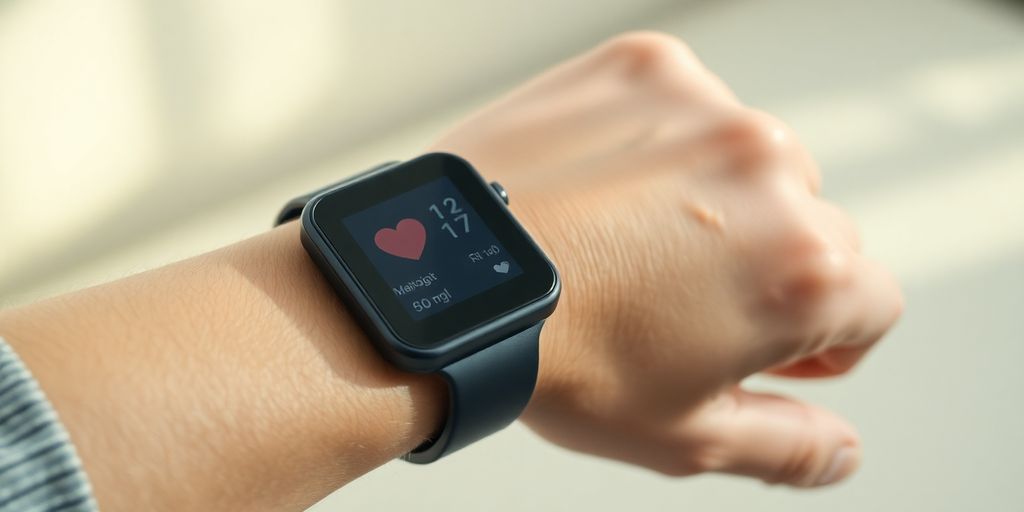What is a Good HRV, and Why Does it Vary for Everyone? Understanding Your Unique Heart Rate Variability

Ever wondered why some days you feel like you can conquer the world, and other days just getting out of bed feels like a marathon? A big part of that might come down to something called Heart Rate Variability, or HRV. It’s not just about how fast your heart beats, but how much the time between those beats changes. Understanding your HRV can give you some pretty cool insights into your body’s readiness, but here’s the thing: What is a Good HRV and why does it Varies for Everyone? Let’s figure out what this personalized metric means for you.
Key Takeaways
- HRV measures the tiny changes in time between your heartbeats, showing how adaptable your body is.
- Your HRV is unique to you; comparing it to others isn’t really helpful because so many things affect it.
- Focusing on your personal HRV trends over time is much more useful than a single day’s number.
- Many things, like your age, genetics, sleep, and how much you exercise, can change your HRV.
- You can improve your HRV by making smart choices about your training and daily habits, like getting good sleep and managing stress.
Understanding Heart Rate Variability
What is Heart Rate Variability (HRV)?
Heart rate variability, or HRV, is basically the variation in the time intervals between your heartbeats. It might sound a bit technical, but it’s actually a pretty straightforward concept. Think of it this way: if your heart is beating at 60 beats per minute, it doesn’t mean it’s beating exactly once every second. There are tiny differences in those intervals. These variations are what we measure as HRV. A higher HRV generally indicates that your body is more adaptable and resilient to stress.
HRV and the Autonomic Nervous System
HRV is closely linked to your autonomic nervous system (ANS), which controls many of your body’s automatic functions, like heart rate, digestion, and breathing. The ANS has two main branches:
- The sympathetic nervous system (your "fight or flight" response).
- The parasympathetic nervous system (your "rest and digest" system).
- These two systems work in balance to keep your body in a state of equilibrium.
HRV reflects the interplay between these two branches. A higher HRV often indicates a dominance of the parasympathetic system, suggesting better recovery and adaptability. Monitoring your lifestyle choices can help you understand how your body responds to different stimuli.
What Do HRV Numbers Mean?
Okay, so you’re tracking your HRV, but what do the numbers actually mean? Well, there isn’t a single "good" number for everyone. HRV is highly individualized, and what’s normal for one person might be completely different for another. Generally, a higher HRV is associated with better fitness and overall health. However, it’s more important to look at your own trends over time rather than comparing your numbers to others. A gradual increase in your average heart rate variability is a positive sign, indicating that you’re improving your fitness and well-being.
It’s important to remember that HRV is just one piece of the puzzle when it comes to assessing your health and fitness. It should be considered alongside other metrics, such as sleep quality, stress levels, and overall well-being.
What is a Good HRV and Why Does it Vary for Everyone?

What is a Good Heart Rate Variability?
So, what’s a good HRV? Honestly, it’s complicated. A higher HRV generally indicates better fitness and readiness, but it’s not a one-size-fits-all kind of thing. What’s considered "good" varies wildly from person to person. It’s more about understanding what’s normal for you than chasing some arbitrary number. If you’re new to this, it might be worth checking out an ultimate guide to HRV to get a better grasp of the basics.
HRV is Highly Individualized
HRV is super sensitive. It changes a lot during the day, from one day to the next, and definitely from one person to another. People often ask, "What should my HRV be?" and "How does my HRV compare to others?" Younger folks tend to have higher HRV than older folks, and men sometimes have a bit higher HRV than women. Even elite athletes usually have greater heart rate variability than the rest of us. But, none of this is set in stone. There are plenty of super fit people out there whose HRV is regularly in a lower range. What’s healthy differs for everyone. Better questions to ask are, "What’s a good HRV trend for me?" and "What can I do to make that happen?"
What is a Normal Heart Rate Variability?
Here’s a general idea of average HRV based on age:
| Age | Average HRV Range (ms) |
|---|---|
| 20-25 | 55-105 |
| 60-65 | 25-45 |
Keep in mind that these are just averages. Your "normal" might be higher or lower. It’s more useful to track your own trends and see how your HRV responds to changes in your life. You can use this information to make lifestyle changes, such as increasing your activity levels or working to reduce your stress levels.
If you track your HRV data at home using a smartwatch or fitness tracker, it’s a good idea to compare your data to your own baseline. Generally, a higher HRV is considered “better” than a lower HRV, but this varies from person to person. If you notice any major shifts in your HRV, talk with a healthcare professional.
The Importance of HRV Trends
Heart Rate Variability Trends are What Matters
When you start monitoring your heart rate variability, you’ll probably notice it jumps around a lot. Don’t sweat it! This is totally normal because so many things can affect it. Comparing your HRV to your friend’s number today doesn’t really tell you anything about who’s fitter. The real value of HRV comes from watching your own trends over time. If you’re working on your fitness and health, you should see your average HRV gradually climb.
Think of your HRV trends like checking the weather. One sunny day doesn’t mean summer’s here, and one rainy day doesn’t mean it’s winter. You need to look at the patterns to understand what’s really going on.
On the flip side, a downward trend over a few days is worth paying attention to. It could be a sign you’re pushing too hard, not sleeping enough, getting sick, eating poorly, or forgetting to hydrate. Here are some things to consider:
- Are you getting enough sleep?
- Is your nutrition on point?
- Are you managing stress effectively?
Interpreting Your Personal HRV Trends
Okay, so you’re tracking your HRV. Now what? It’s all about understanding what your numbers mean for you. Don’t get hung up on comparing yourself to others. Instead, focus on establishing a baseline and watching how your HRV responds to changes in your life. For example, if you start a new training program, you might see your HRV dip initially as your body adapts. But over time, as you get fitter, it should start to climb again.
Here’s a simple way to think about it:
- Establish a Baseline: Track your HRV for a couple of weeks to get a sense of your normal range.
- Identify Patterns: Look for correlations between your HRV and your activities, sleep, stress levels, and diet.
- Adjust Accordingly: Use what you learn to make adjustments to your lifestyle and training.
It’s also a good idea to choose the best credit card that offers rewards for health and fitness purchases, as this can further incentivize healthy habits that positively impact your HRV. Remember, HRV is just one piece of the puzzle. It’s a tool to help you understand your body better, not a crystal ball.
Factors Influencing Your HRV

Factors that Affect Heart Rate Variability
Lots of things can mess with your HRV. It’s not just one thing; it’s a whole bunch of stuff all interacting. Think of it like this: your body is constantly trying to balance itself, and HRV is just one way to see how well it’s doing. So, what throws off that balance?
- Stress, both physical and emotional, can lower your HRV.
- Poor sleep quality or not enough sleep will definitely impact it.
- Dehydration can also play a role.
- Even your mood can affect your HRV scores.
It’s important to remember that a single low HRV reading isn’t necessarily cause for alarm. It’s more about the trends over time.
Biological Factors and HRV
Some things you just can’t change. Your age is a big one; HRV tends to decrease as you get older. Genetics also play a role; some people are just naturally predisposed to have higher or lower HRV than others. Gender can also be a factor, with some studies showing differences between men and women. Certain medical conditions can also impact your HRV. For example:
- Heart conditions
- Diabetes
- Autoimmune diseases
Lifestyle Choices and HRV
This is where you have the most control. Your daily habits can significantly impact your HRV. Think about it: what you eat, how much you exercise, and how well you manage stress all play a role. Here’s a breakdown:
- Diet: Processed foods, sugary drinks, and an unbalanced diet can lower HRV. Focus on whole, unprocessed foods.
- Exercise: Regular physical activity can improve HRV, but overtraining can have the opposite effect. Finding the right balance is key. Consider intelligent training.
- Stress Management: Chronic stress is a major HRV killer. Find healthy ways to manage stress, such as meditation, yoga, or spending time in nature.
- Sleep: Aim for 7-9 hours of quality sleep per night. Create a relaxing bedtime routine and make sure your bedroom is dark, quiet, and cool.
- Substance Use: Smoking and excessive alcohol consumption can negatively impact HRV. Quitting smoking and limiting alcohol intake can improve it.
Ultimately, understanding these factors can help you make informed choices to support a healthier heart and a more resilient nervous system. Monitoring your heart rate variability can provide valuable insights into your overall well-being.
Improving Your Heart Rate Variability
How to Improve Heart Rate Variability
Okay, so you’ve been tracking your HRV and maybe it’s not where you want it to be. Don’t stress! The good news is that there are things you can do to nudge it in the right direction. It’s not about overnight miracles, but consistent effort. Think of it like tending a garden; small, regular actions yield the best results over time.
- Prioritize Sleep: Aim for 7-9 hours of quality sleep each night. A dark, quiet, and cool room can make a big difference.
- Manage Stress: Find healthy ways to cope with stress, such as meditation, yoga, or spending time in nature.
- Stay Hydrated: Dehydration can negatively impact HRV, so drink plenty of water throughout the day.
Improving HRV is a marathon, not a sprint. Consistency is key, and it’s about finding what works best for you.
Intelligent Training for Better HRV
If you’re an athlete, or just someone who works out regularly, your training can have a big impact on your HRV. Overtraining is a common culprit for a dip in HRV, so it’s important to listen to your body and adjust your training accordingly.
- Avoid Overtraining: Give your body adequate rest and recovery time between workouts.
- Incorporate Recovery Days: Schedule rest days into your training plan to allow your body to recover and rebuild.
- Monitor Your HRV: Use your HRV data to guide your training decisions. If your HRV is low, consider taking a rest day or reducing the intensity of your workout.
Lifestyle Adjustments for Optimal HRV
Beyond training, there are several lifestyle adjustments you can make to improve your HRV. These changes might seem small, but they can add up to make a big difference in your overall health and well-being.
- Nutrition: Eat a balanced diet rich in fruits, vegetables, and whole grains. Limit processed foods, sugary drinks, and excessive caffeine.
- Mindfulness: Practice mindfulness techniques, such as meditation or deep breathing exercises, to reduce stress and promote relaxation.
- Limit Alcohol: Excessive alcohol consumption can negatively impact HRV, so drink in moderation or abstain altogether.
HRV as a Personalized Metric
Why Your HRV is Unique
Your heart rate variability is a deeply personal metric. It’s influenced by a complex interplay of factors, making direct comparisons to others often misleading. What’s considered a "good" HRV for one person might be drastically different for another. Things like age, sex, genetics, fitness level, and even daily stress all play a role. Instead of focusing on external benchmarks, it’s more useful to understand your own baseline and how it responds to changes in your life. For example, airline miles credit card benefits can vary greatly, so understanding your own travel habits is key.
Comparing Your HRV to Others
While comparing your HRV to others can be tempting, it’s important to approach this with caution. Remember that HRV is highly individualized. A young, elite athlete will naturally have a different HRV than an older, sedentary individual. Even within similar demographics, significant variations can exist. Instead of striving to match someone else’s numbers, focus on understanding what’s normal for you and tracking your own trends over time.
Focusing on Your Individual HRV Journey
Think of your HRV as a personal compass, guiding you toward better health and well-being. Here’s how to make the most of your individual HRV journey:
- Establish a baseline: Track your HRV consistently for several weeks to understand your typical range.
- Identify patterns: Look for correlations between your HRV and lifestyle factors like sleep, stress, and exercise.
- Make informed adjustments: Use your HRV data to guide your training, recovery, and stress management strategies.
Ultimately, your HRV is a reflection of your body’s unique response to the world around you. By understanding your individual patterns and trends, you can gain valuable insights into your health and optimize your well-being.
Wrapping It Up: Your HRV Story
So, what’s the big takeaway here? Your HRV isn’t just some random number; it’s a pretty cool look into how your body is doing. It’s not about hitting a certain number that someone else has. Nope, it’s all about what’s normal for you and how your numbers change over time. Think of it like your own personal health diary, showing you when you’re doing great and when you might need to chill out a bit. By paying attention to your HRV, you can make smarter choices about your workouts, sleep, and just generally how you live. It’s a simple way to get a better handle on your health, and that’s pretty awesome.
Frequently Asked Questions
What does HRV mean?
HRV stands for Heart Rate Variability. It measures the tiny differences in time between each of your heartbeats. It’s not about how fast your heart beats, but how much the time between beats changes.
What is considered a good HRV?
A ‘good’ HRV isn’t a single number. It’s really about what’s normal for *you*. Generally, higher HRV suggests your body is well-rested and ready for action, while lower HRV might mean you’re stressed, tired, or getting sick.
How does HRV relate to my body’s systems?
Your HRV is controlled by your autonomic nervous system, which has two parts: one for ‘rest and digest’ and one for ‘fight or flight.’ A healthy HRV means these two parts are working well together, helping your body adapt to different situations.
What factors can influence my HRV?
Many things affect your HRV, like your age, gender, and even your genes. Your daily habits also play a big role, such as how much you exercise, how well you sleep, what you eat, and how stressed you are.
Should I compare my HRV to other people’s?
Instead of comparing your HRV to others, focus on your own trends. If your HRV generally goes up over time, it’s a good sign you’re getting fitter and healthier. If it consistently drops, it might be a signal to slow down or check in with your health.
How can I improve my HRV?
To improve your HRV, focus on healthy habits. This includes getting enough good sleep, eating well, managing stress, staying hydrated, and exercising smartly without overdoing it. Listening to your body is key.








Responses